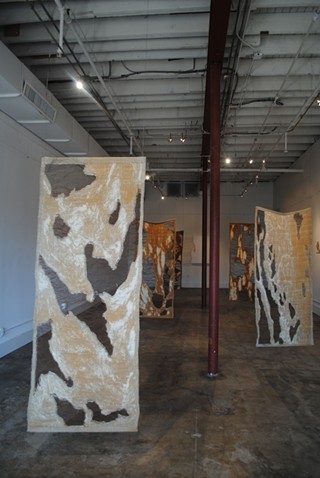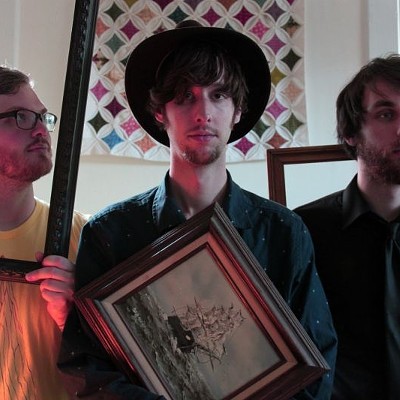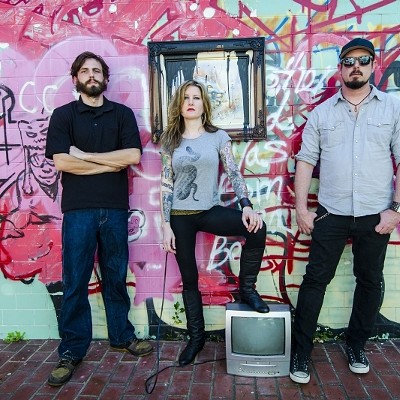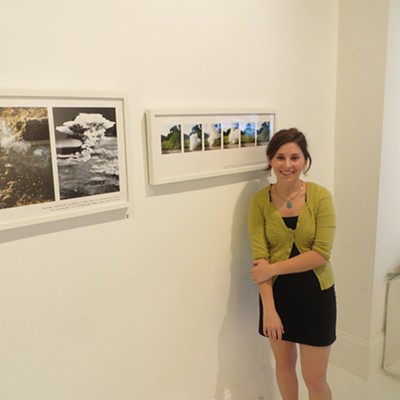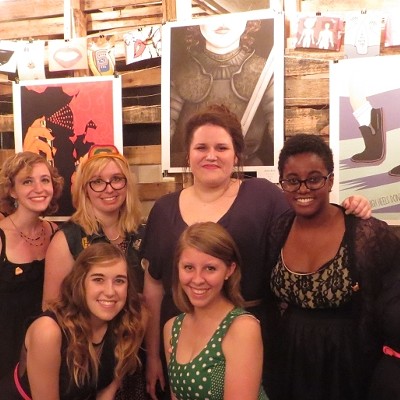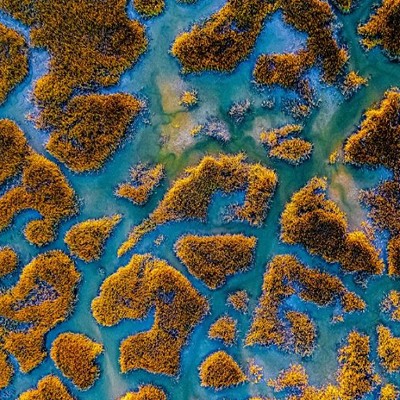THIS PAST Sunday afternoon, after the clock fell behind, I visited Ashmore Gallery on MLK to witness things that fall apart. There, Jennifer E. Moss presents her MFA thesis exhibition Transient Structures, a series of tapestries that weave together the scientific laws of entropy and the aesthetic theories of beauty.
From the ceiling hang five semitransparent sculptures that are in various stages of oxidation and disintegration. Along the walls are newer works of embroidery on paper, which are less prone to decay but impermanent nonetheless.
They are a parallel body of work to her tapestries that represent "the give and take of order and disorder in nature." Both sets of work are palpable demonstrations of the effects of time on linen, iron, paper and metal.
In her artist's statement, Moss describes the process that takes place in her work: "As rust appears on the surface of the weavings and eventually falls away in a fine dust, the sense of nature's power to overcome and degrade is made tangible."
Although these structures will eventually become ashes and dust, for the moment they also convey stillness; a feeling of time being suspended within the fibers and metal of the weavings. All together they create a sense of stability rising from instability and hope rising from despair.
The five sculptures suspended from the ceiling are woven with linen and iron using the modern Jacquard loom; a machine capable of producing textiles from photographs such as the ones that Moss has taken in the weathered parts of the world.
On the computer Moss then elongates or condenses these photographs to abstraction before transferring them onto the fabric, which then creates intricate patterns on the weavings. The results of this technology are a marvel to behold.
After the machine has completed its task Moss transforms this two-dimensional surface into a sculpture by removing pieces of linen from the woven tapestry and stretching the iron wire into transparent mountains. These peaks and valleys of raised wire form imperfect lines in impermanent objects.
Just as the threads are stretched across the loom each object stretches across time, demonstrating its effects. Days, weeks and months have already taken their toll on these structures and each piece bears the signs of the irreversibility of decay.
The youngest of these sculptures hangs in the front of the gallery. It is only two weeks since it has been removed from the loom and yet rust has begun to accumulate along the metal, accelerated by a solution of salt and water. Although the oldest object has been off the loom for only two months, it is aged and worn by its exposure to the elements.
The time, light, and air that pass through these porous sculptures have left their marks upon the surfaces, as only they are able to do, creating rust from iron and a past from the present. As a consequence of oxidation, there is an overwhelming sense of loss in each of these structures that the loss of control and the loss of time are etched along the soon-to-be unraveled threads of linen and iron.
These staggered objects of manipulated iron wire and linen invite the viewer to experience the passage of time through their rusty corridors, often entering into seas of burnt sienna and umber rings of rust.
As you walk around each structure you may be overcome with the desire to run your hands along the threads in order to feel the malleability of the iron, the texture of rust and time slipping through your fingers.
Although these melancholy objects will eventually cease to exist, they are is still a balance of order and disorder, flourish and decay, life and death. Her pieces represent an entropic descent into chaos from which there is no return and yet when Moss speaks of her work it is with the quiet acceptance of intentionally creating things that are not permanent.
Although their beauty is ephemeral, there is still beauty in the chaos of these objects. It can be seen in the softening of the hard metal and the linen that bleeds from its contact with rusting iron. It can also be found in the way these semi-opaque sculptures interact with one another and the silent progression of time unfolding within the folds of fiber and metal.
These transient structures will rust and they will eventually disintegrate onto the floor but they will always remain beautiful in their impermanence.

